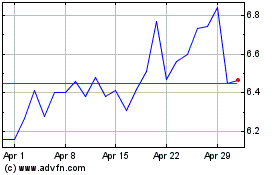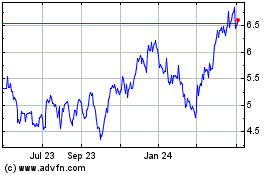By Alistair MacDonald
Gold miners are riding high as the metal trades at record
prices, but digging it out of the ground is getting harder.
Gold is among the rarest metals in the earth's crust and much of
the easier-to-get ore has already been mined. What is left is
harder to find and more expensive to extract, miners say.
While that isn't an immediate worry, with gold prices hitting
$2,000 an ounce for the first time this month, miners face the
longer-term prospect of higher costs and drilling in less
hospitable places. A sharp selloff in gold this week also reminded
companies that high prices can't be taken for granted.
Gold prices are up around 28% this year. Miners have used the
rally to pay down debt and increase dividends, rather than start
new projects, with executives wary of repeating their costly
overexpansion during the last big run-up in prices.
"We are definitely past peak gold," said Mark Bristow, chief
executive of Barrick Gold Corp., the world's second-largest gold
miner by market capitalization. He estimates that the new metal
added to miners' reserves since 2000 replaces only half of the gold
they mined in that period.
Miners are spending less money on finding new gold, with the
industry's exploration budget at $4.44 billion last year, 63% lower
than its record high in 2012, according to Australia-based Minex
Consulting.
That comes as finding new gold is becoming more expensive as
miners have to dig deeper and enter more remote terrain in search
of untapped deposits. The average cost to find an ounce of gold was
$62 between 2009 and 2018, more than double the cost for the
previous decade, according to Minex.
"What new fresh discoveries have been made? Not a lot," said
Sean Boyd, the chief executive of Agnico Eagle Mines Ltd, a
Canada-based mining company that has turned to the Arctic to find
higher quality deposits. "If they have, they've been found in tough
parts of the world," he said.
The grade of gold being mined -- the amount of metal for every
ton of rock mined -- is also getting worse. The average mine grade
has fallen from over 10 grams a ton in the early 1970s to around
1.46 grams a ton last year, according to Metals Focus, a
precious-metals consulting firm.
Lower grades of gold require digging up more earth to find the
metal so are more expensive per ounce to mine. In 1990, the cost of
mining an average ounce of gold, calculated by looking at the total
cash costs plus capital expenditure, was $253, according to
Refinitiv. Last year it was $705.
The fundamental problem for gold miners is that there simply
isn't that much to unearth. All the gold ever mined can fit into a
69-foot cube, according to the World Gold Council. At around 0.005
parts per million, gold's presence in the Earth's crust is tiny
compared with that copper, at over 50 parts, or iron, at more than
50,000.
Some miners and geologists argue the metal is nowhere near to
running out as a minable commodity. Gold may be harder to mine, but
technology can bring costs down and allow access to new
mineral-rich places, such as the ocean floor, they say.
"We say we are running out, but we are not really looking," said
Ferri Hassani, a professor at the Department of Mining and
Materials Engineering at Canada's McGill University. Mr. Hassani
said, for instance, that nobody thought there would be gold in
Iran, but geologists are finding it there.
People have talked of mining the ocean floor since the 1870s,
when a British Navy research vessel charted nodules containing
metal deposits throughout the seas. Aside from diamonds relatively
close to the shore, oceans remain untapped, while most miners
aren't keen on digging in politically risky places like Iran.
Lower gold supplies won't necessarily make the metal more
expensive for buyers. Supply doesn't affect gold prices in the way
it does other commodities, given the metal's status as a financial
asset as much as a material for use.
The recent rally was driven by investors seeking havens amid the
coronavirus pandemic and persistently low, and in some cases
negative, interest rates. Gold is less attractive against other
safe-haven assets, like U.S. Treasurys, when rates are high.
Also, unlike many other commodities, like oil, the supply of
this virtually indestructible metal doesn't disappear.
Meanwhile, gold miners are enjoying the bounty of higher prices
when Covid-19 has disrupted production and increased costs. Share
prices have jumped, with Barrick Gold and Newmont Corp. both up
around 47% this year and Kinross Gold Corp. 88% higher.
Gold companies are doling out dividends. Barrick Gold announced
an increase of 14% for its second-quarter payout, while Newmont has
increased its dividend by 79%.
South Africa's Gold Fields Ltd. said it would capitalize on the
high gold price by paying down around $750 million in debt by the
end of the year.
Still, miners say they aren't ramping up production, which has
gradually increased over the last decade to 108 million ounces last
year, according to Refinitiv.
Barrick, Newmont, Agnico Eagle and others say they will only
approve new projects if they can make money with gold at $1,200,
about 40% below where the metal is trading. During the last gold
price bull run, which peaked in the fall of 2011, miners increased
their reserves, started expensive new projects and went on
acquisition sprees, much of which turned sour as the price fell 43%
in the following four years.
"Everyone kept changing their cut off grade and following the
gold price, " said Barrick's Mr. Bristow.
This time, said Agnico Eagle's Mr. Boyd, "The key will be to
show that industry has not lost its discipline."
Write to Alistair MacDonald at alistair.macdonald@wsj.com
(END) Dow Jones Newswires
August 16, 2020 08:14 ET (12:14 GMT)
Copyright (c) 2020 Dow Jones & Company, Inc.
Kinross Gold (NYSE:KGC)
Historical Stock Chart
From Mar 2024 to Apr 2024

Kinross Gold (NYSE:KGC)
Historical Stock Chart
From Apr 2023 to Apr 2024
